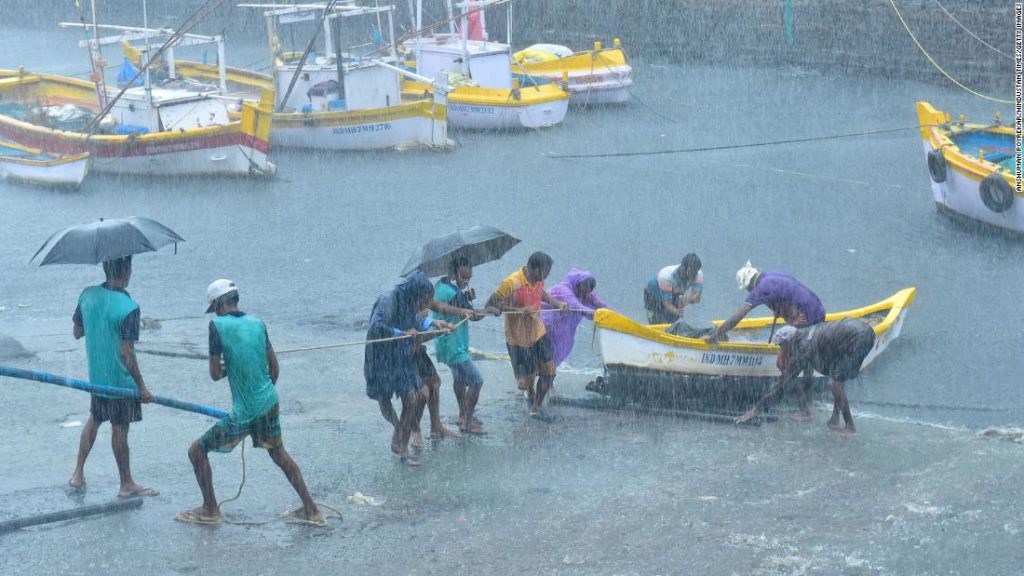Tropical Cyclone Tauktae, a storm with wind speeds equivalent to a high-end Category 3 hurricane that formed in the Arabian Sea, made landfall Monday night local time in Gujarat. It strengthened slightly as it hit the western state with maximum sustained winds of 205 kilometers per hour (125 mph), according to the United States’ Joint Typhoon Warning Center.
By Tuesday morning, it had weakened from an “extremely severe cyclonic storm” to a “severe cyclonic storm,” according to the Indian Meteorological Department (IMD).
Photos and videos show highways turned into rivers by the heavy rain, and trees and power lines toppled by ferocious winds. The cyclone has killed at least 26 people across the coastal states of Gujarat, Kerala, Karnataka, Goa and Maharashtra, according to state authorities.
The deaths were due to drowning at sea, house collapses, lightning strikes and other accidents linked to the severe weather, according to states’ disaster management authorities.
Covid patients were among the hundreds of thousands evacuated from low-lying areas this week as the region braced for the cyclone’s arrival. In Mumbai, 580 patients from makeshift care centers were moved to various hospitals on Friday and Saturday, according to the city’s municipal corporation.
Back then, however, India’s cases were still relatively low, at fewer than 10,000 a day, and the country was emerging from a stringent lockdown.
And the cyclone could be just the harbinger of more disaster to come, as India’s months-long monsoon season approaches.
‘A terrible double blow’
More than 200,000 people in Gujarat have been evacuated from coastal areas, said the state’s chief minister, Vijay Rupani, on Monday. More than 2,435 villages lost power, though 484 have since had it restored.
Storm surges of up to 13 feet (4 meters) could bring significant coastal flooding to the region, the IMD warned. Ahmedabad, the most populated city in Gujarat, could see nearly 4 inches (102 mm) of rainfall in the next 24 to 48 hours — more than its average rainfall from January through June.
Thousands of people in Kerala and Karnataka are seeking refuge in relief camps, with many homes damaged by extreme weather, according to the chief ministers of both states.
India’s National Disaster Response Force (NDRF) has deployed more than 100 teams across six coastal states to help efforts on the ground. The Indian military has also been deployed; on Tuesday, the Navy said it rescued 177 people from a barge that sank in an offshore oilfield off the coast of Mumbai.
The cyclone, which is tracking north, is also impacting the pandemic relief effort.
Among the 400 Covid-19 hospitals in Gujarat, power supply has been disrupted to 100, said Rupani on Tuesday. All the hospitals have backup generators — but these appliances failed at four hospitals, leaving them without electricity.
Authorities are working to repair the affected generators, Rupani said. Vaccinations have been suspended across Gujarat.
“The big concern was that of Covid,” he said. “The oxygen which we produce has been transported to our hospitals, but we also have to send oxygen to other states such as Maharashtra, Rajasthan, Delhi, Haryana, etc.”
Oxygen production is ongoing even throughout the cyclone, he said.
“Many families are barely staying afloat,” he added.
A curfew was already in place across 36 cities in Gujarat as part of its Covid restrictions. It had been scheduled to end on Tuesday, but has now been extended for three more days because of the cyclone, Rupani said.
The impending monsoon season adds another layer of complication. Every year, heavy monsoon rains begin in June and last through early fall, replenishing water supplies that farmers rely on to feed their crops.
But the rainfall also consistently overwhelms flood management systems, and causes significant damage in hard-hit areas.
Though this year’s monsoon season isn’t scheduled to start until June 1, it might arrive early due to Cyclone Tauktae’s landfall and the change of winds, according to CNN meteorologists.
You may also like
-
Afghanistan: Civilian casualties hit record high amid US withdrawal, UN says
-
How Taiwan is trying to defend against a cyber ‘World War III’
-
Pandemic travel news this week: Quarantine escapes and airplane disguises
-
Why would anyone trust Brexit Britain again?
-
Black fungus: A second crisis is killing survivors of India’s worst Covid wave

